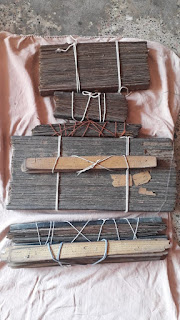In the vernacular of yesteryear Coimbatore, when a
man deserts his wife and children, he is said to have gone as a Samiyar, though he would not literally
become an ascetic. People used the term to indicate a man, who either remained a
bachelor or renounced his married life. But, in a village near Tirupur, some
150 years ago, a man gave up his domestic life, literally became an ascetic and
spent the rest of his life at the Avinashi Lingeshwarar Temple, which is one of
the seven celebrated shrines of Kongunadu. The hermit was a Tamil scholar,
whose writings in palm leaf are still treasured by his descendants.
“ ‘Vadhiyar Swamigal’, as he was called, taught the children of his village at his
house pyol, though his major
occupation was weaving” informs Pulavar Sundara Ganesan, a history enthusiast
and headmaster of Panchayat Union Elementary School, Chellammal Colony, Tirupur.
A diploma holder in epigraphy, Sundara Ganesan
stumbled upon the palm leaf manuscripts of Vadhiyar Swamigal and he has taken
up the work of deciphering them in order to bring into books. However, ‘Siva
Thothira Thirattu’ a piece of bhakthi
literature penned by Vadhiyar Swamigal got published in 1969 by his disciple A.
Ramasamy Naidu of Coimbatore.
“The natural name of Vadhiyar Swamigal was ‘Ammasai’.
He got the name ‘Vadhiyar Swamigal’ as he taught the children of his village. Nevertheless,
the teacher cum weaver had a wish to
become a disciple to any god man. Therefore, one day, he walked to the Avinashi
Lingeshwarar Temple via Periyayipalayam. At the ‘Pukkuzhiyur Mutt’ (
Pukkuzhiyur was the name of Avinashi in the bygone era) near the shrine, he met Arivanandha Swamigal, a sanyasi.
 |
| The palm leaf manuscripts of ' Vadhiyar Swamigal' |
Ganesan says that Arivananda Swamigal would not accept
anyone as his disciple, unless the latter was capable of reciting a song, which
he would be allowed to listen to only once. With Vadhiyar Swamigal clearing this
test, the ascetic accepted him as his disciple.
 | |
| Pulavar Sundara Ganesan |
“Arivananda Swamigal, thereafter, assigned him the
job of Deepa Kaingaryam ( Regularly burning
lamp in the temple). However, Vadhiyar Swamigal, who is said to be good at
astrology and indigenous medicine, had written many works on palm leaf. His descendants
have been treasuring the manuscripts” informs Sundara Ganesan, who learned the
art of deciphering stone inscriptions and palm leaf manuscripts from the late ‘Avinashi’
Ma. Ganesan, a popular epigraphist of Coimbatore.
Ganesan says that he was interested to know whether
the palm leaf manuscripts of Vadhiyar Swamigal could contain references on the
Tirupur of the bygone era.
Citing from Alagumalai
Kuravanji, a bhakthi piece of
literature on the hill shrine ‘Alagumalai’, Ganesan
says that the work mentions ‘ Tirupur’ as ‘ Thirupayyur’.
“I have been tracing the etymology of ‘Thirupayur’
and I am yet to know what the place name means” “says Ganesan.
Link to the article in The New Indian Express: http://epaper.newindianexpress.com/c/29099721






